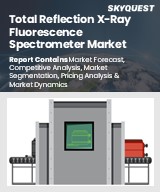
Report ID: SQMIG35D2297
SkyQuest Technology's Total reflection x-ray fluorescence spectrometer market size, share and forecast Report is based on the analysis of market data and Industry trends impacting the global Total Reflection X-Ray Fluorescence Spectrometer Market and the revenue of top companies operating in it. Market Size Data and Statistics are based on the comprehensive research by our Team of Analysts and Industry experts.
Global Total Reflection X-Ray Fluorescence Spectrometer Market size was valued at USD 3.3 billion in 2023 and is poised to grow from USD 3.53 billion in 2024 to USD 6.02 billion by 2032, growing at a CAGR of 6.9% during the forecast period (2025-2032).
The total reflection x-ray fluorescence spectrometer market is experiencing significant growth due to its advanced capabilities in providing non-destructive, ultra-sensitive elemental analysis. TXRF spectrometers are widely used across various industries for detecting trace elements and contaminants, making them essential in sectors such as pharmaceuticals, food safety, and environmental monitoring. This growth is driven by the increasing need for precision in regulatory compliance, quality control, and environmental monitoring.
The demand for TXRF spectrometers is particularly high in North America, where strong research investments and a thriving pharmaceutical sector are major contributors to global total reflection x-ray fluorescence spectrometer market growth. Europe also plays a significant role, with stringent environmental regulations and continuous advancements in research and development driving demand for these devices. The Asia-Pacific region is rapidly expanding, fueled by increased industrial production and the growing emphasis on quality control across manufacturing sectors.
Technological innovations in TXRF, such as the development of energy-dispersive spectrometers, are improving the efficiency and accuracy of elemental analysis. These advancements are making the technology more accessible and applicable across a broader range of industries.
How is AI Revolutionizing the Total Reflection X-Ray Fluorescence Spectrometer Market?
Artificial Intelligence (AI) is significantly transforming the total reflection x-ray fluorescence spectrometer market by enhancing operational efficiency, accuracy, and automation. AI-driven algorithms are being incorporated into TXRF systems to streamline complex spectral data analysis. This leads to faster and more precise quantification of trace elements, benefiting industries that rely on high-precision elemental analysis, such as pharmaceuticals, environmental monitoring, and semiconductor manufacturing. Machine learning models help detect patterns and anomalies in spectral outputs, improving the reliability of results while reducing the need for manual interpretation. Moreover, AI supports automation in sample handling, calibration, and data processing, which minimizes human error and boosts throughput, an essential factor in high-demand lab environments.
REQUEST FOR SAMPLE
Global Total Reflection X-Ray Fluorescence Spectrometer Market size was valued at USD 2.67 Billion in 2023 and is poised to grow from USD 2.83 Billion in 2024 to USD 4.55 Billion by 2032, growing at a CAGR of 6.13% in the forecast period (2025-2032).
In the competitive landscape of the global total reflection x-ray fluorescence spectrometer industry, key players are focusing on technological advancements and product innovations to gain a competitive edge. Prominent companies like Thermo Fisher Scientific and HORIBA Scientific have strengthened their market positions through strategic investments in R&D and by offering products that provide higher precision and sensitivity. These companies are targeting diverse industries such as pharmaceuticals, environmental testing, and food safety, which are increasingly relying on advanced instruments for accurate and efficient analysis. A notable strategy in the market has been the development of user-friendly and compact TXRF spectrometers, catering to both large-scale laboratories and smaller research facilities. 'Shimadzu Corporation', 'Rigaku Corporation', 'Metrohm Process Analytics', 'AMETEK Inc.', 'Bruker Corporation', 'Thermo Fisher Scientific Inc.', 'Horiba Ltd.', 'Malvern Panalytical Ltd.', 'PANalytical B.V.', 'Oxford Instruments Plc', 'Agilent Technologies Inc.', 'Hitachi High-Technologies Corporation', 'JEOL Ltd.'
Process analytical technology (PAT) is a system for the design, analysis, and control of manufacturing processes through the measurement of critical process parameters. Various technologies, process control software, PAT systems, and others need to be integrated in order for this system to be adopted. PAT has a major role to play in the development and scale-up of asymmetrical chiral molecule synthesis processes within the pharmaceutical sector.
Increased Funding by the Government: Government from various regions with increased interest in developing spectroscopy techniques with increased utilization of the technology in various industries for testing the sample and increased output with improved results help to expand the market. Providence from the government for development of spectroscopy with innovations in the method with rising demands from the professionals which gives accurate results with interpretation. Which helps to boost the global total reflection x-ray fluorescence spectrometer market trend during the forecast period.
How is North America's Dominance in Research and Development Boosting Market Sales?
Want to customize this report? This report can be personalized according to your needs. Our analysts and industry experts will work directly with you to understand your requirements and provide you with customized data in a short amount of time. We offer $1000 worth of FREE customization at the time of purchase.
Feedback From Our Clients

Report ID: SQMIG35D2297
sales@skyquestt.com
USA +1 351-333-4748